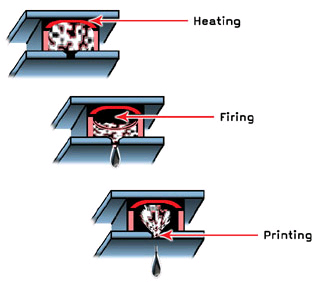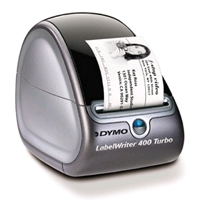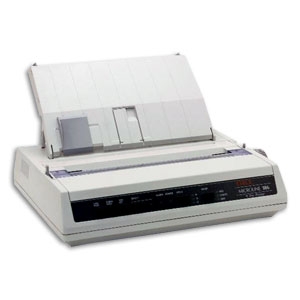This guide will help you gain the knowledge to be able to choose the right printer for your needs. This will help you decide which printer is best for you.
Printers: What, How, and Why?
Most users are at least a little confused by the seemingly endless array of printer models available. Trying to decide if a laser printer is a worthy purchase for your home, or if an inkjet is right, can be difficult. Most people work frequently with a printer of some sort, either at home or at the office. But does working with a printer mean that we understand what it is capable of? This guide will help you understand the different technologies used in printers. Combined with this knowledgeable guide and an idea of the particular printing capability you want, you will be able to make a much more informed purchase.
Printer Types
Today there are almost a dozen different printer types available, and each has its advantages and solutions to your needs.
While some of these are for very specialized applications, we will focus on the most common personal and business printers.
Inkjet Printers are probably the most common type of printers used today. Inkjet technology is used in everything from very inexpensive home printers to top of the line professional quality wide format sign printers. Inkjet printers have come a long way within the past 20 years. What was once extremely an expensive, low quality, loud and slow printer is now quite the opposite. Today's inkjet printer can print out an average of 13 to 15 Pages Per Minute (PPM) in black and 11 to 13 PPM in color. Some inkjet printers can print 30+ PPM (pages per minute) in color and black. These print speeds are based on the type of documents you are printing (coverage and resolution). You can find a huge assortment of printers to choose from various manufacturers (such as Hewlett Packard, Lexmark, Cannon, Epson, and many more).

An inkjet works by heating and jetting ink onto the page!
Resolution The number one factor that determines the quality of a printer is the printer's resolution or DPI (Dots Per Inch). DPI is the amount of ink that an inkjet printer can place in a one-inch line of your print document. Most inkjet printers produce documents at 600 x 600 DPI, though many now have much higher resolutions. This is the principal quality measurement for most printers. Some printers have the ability for you to increase the DPI to 4800 DPI to print various documents. The majority of the inkjet printers on the market today also print photographs with impressive quality.
The number one factor that determines the quality of a printer is the printer's resolution or DPI (Dots Per Inch). DPI is the amount of ink that an inkjet printer can place in a one-inch line of your print document. Most inkjet printers produce documents at 600 x 600 DPI, though many now have much higher resolutions. This is the principal quality measurement for most printers. Some printers have the ability for you to increase the DPI to 4800 DPI to print various documents. The majority of the inkjet printers on the market today also print photographs with impressive quality.
 Networking & WiFi
Networking & WiFi
Many of the inkjet printers on the market today will also allow you to connect them to a home or small business network (via CAT5 cable or wireless WiFi). This feature can provide a great cost savings - allowing multiple computers to connect to one inkjet printer. In addition to networkable printers, some inkjet printers also feature memory card readers and LCD screens - allowing you print without the need to use your computer, so you can see your print job before you print it.
Advantages of Inkjet Printing
The most obvious advantage to inkjet printers is cost. These types of printers range from very expensive to actually costing less than the ink cartridges that they use inside. This is possible because manufacturers are willing to slash the printer price to make their profit from the cartridge and paper sales, rather than the printers themselves. Because many inkjet printers use ink cartridges that contain their own print heads, a well maintained inkjet could last for an absurdly long time (the main limit on a printer's life span is availability of the replaceable cartridges). Inkjets are also capable of printing onto a large variety of print media. Some Industrial Inkjets can print directly onto products or product packaging. But ever home models are ideal for producing self-adhering labels, brochures, and even iron-on t-shirt designs!
Color inkjet printers are much less expensive than even the most basic color laser printers. A good quality inkjet can produce stunning photo quality prints for a fraction of the price of laser printing. Inkjet technology is still cheaper than dye-sublimation printers capable of the same size paper and workloads, although that technology is catching up quickly. While inkjets are subject to drawbacks like ink cost, they are the most affordable and versatile type of print technology. If you would like a high quality, inexpensive color printer with the capability to produce professional documents, color student projects, and high quality photos - then an inkjet printer is for you.
Photo Printers
Most inkjet printers can also print stunning color photos up to a resolution of 4800 DPI or more. With this level of quality, it is very difficult to determine the difference between a professionally made photograph and a photograph printed on your inkjet printer. Because of this, the difference between a regular Inkjet and a "Photo" printers is sometimes a bit blurry, due to the fact that Inkjet can print photos, and Photo printers use inkjet technology. The main difference is feature set and media format.
A Photo printer typically has specially features to print from camera memory cards/devices, may have a built-in LCD to preview photos, and is designed for printing 4x6 prints. Photo printers frequently have additional ink options that allow them to produce superior images.
Ultimately, the value of a photo printer or a regular inkjet depends on how you will use it. For general use, an inkjet with good photo printing features is probably the best solution. However, buying a dedicated photo printer may be the right choose if you want to print more photos than a few per week. As with all printers, ultimately, you should compare features to find the make and model best for you use.
 Laser Printers
Laser Printers
Normally laser printers are found in offices, however the cost for laser printers has become so reasonable that it is possible to own a professional quality laser printer in your own home. The average resolution of today's laser printer is 1200 x 1200 DPI. This resolution will give you very high quality document printouts. The majority of laser printers on the market today can print an average of 20 PPM (or more) in (black/monochrome). Color laser printers are also available and most can produce color documents up to 2400 DPI and a little less than 20 PPM (color). Color Laser printers are a little more costly and if you want to print high quality photos, its better to use an inkjet or photo printer for most users. The size of laser printers have also decreased from the monstrous machines of the 1980s and 1990s to about the same size as inkjet printers. Another great feature of many laser printers is that they can be connected to a network. Allowing multiple users to access one printer instead of having multiple printers can provide a major cost savings.
How Laser Printers Work
The science behind laser printers is fairly simple. A laser prints the image of the document on a "photoreceptor" drum - causing a static charge on that drum. Toner is released, and sticks where there is a charge, and the excess is removed. It then rolls this onto a page. The laser printer uses this static electricity as a kind of temporary glue. The page with the toner then runs under a "fusing" drum, that melts the toner onto the page. Presto! You have a printed page!
If you work from home, multiple people printing out documents or you seem to print out nearly everything you see on the Internet, look into purchasing a laser printer.
Advantages of Laser Printing
Why buy a laser printer when there are much cheaper inkjet model varieties on the market? The main advantage of laser printers is speed and lower cost per printed page. Lasers (specifically monochrome laser printers) make it possible to complete a large volume of work in short periods of time. This is why many offices and workspaces use at least one laser printer for large document printing. Another advantage is cost. While inkjet printers are far less expensive than the newest state of the art laser printers, inkjet ink cartridges can run out fairly quickly, and depending on the model, be expensive to replace. Laser printers use toner, which has a much longer shelf life, and comes in much larger containers, lasts a long time and costs less.
Color Laser Printers
Color laser printers use a variety of printing technologies. Some use colored ribbons that have to be replaced. Other color laser printers use a a bulk wax approach, using just the amount of each color needed (like a monochrome laser printer). Color laser printers are still expensive, both for the printer and the cost per printed page. Choosing the right technology is critical to meeting your needs and controlling the final cost. However as newer technology is developed and prices continue to drop, watch for high quality electrostatic printing to become more affordable.

Dye-sublimation Printers
Even though inkjet printers are available with extremely high-resolution capabilities, these printers still have their limits. Except for the highest-end printer models, the ink dots can still be detected from a close distance. This can detract from the vibrancy and realism of a digital print, photograph, or other image. Unlike inkjet printing, Dye-sublimation printing does not print as individual dots.
Instead of a toner or ink cartridges, a Dye-sub printer contains a transparent film that resembles cellophane. This film is actually four different transparencies, attached together at either end to form a single ribbon. These four films each are a separate color: Cyan, Magenta, Yellow and black. These four colors combine in differing quantities to make up the millions of colors a printer is capable of producing. This film is imbedded with dyes corresponding to these four colors, which are then laid down to create the colors you see on the printed page. Because this is based upon a dye process, the colors intentionally bleed together (like a real photograph) to produce a continuous color image.
Dye sublimation printers are recommended for graphics and design professionals due to the cost per page, as well as the cost for the printer itself. For most users, color inkjets produce outstanding results.
 Multifunction Printers
Multifunction Printers
Multifunction, or All-In-One printers not only print, but they can also copy, scan, fax - as they not only have a printer, but also a built-in scanner. Multifunction printers are the perfect solution to limited space, or infrequent need for a fax or scanner. They are a great all-inclusive device that can perform all of the functions of several office devices and fit conveniently on your desk.
Multifunction Printers come with either inkjet or laser printer technology. The print quality on most multifunction printers is just the same print quality of most inkjet or laser printers. So buying a Multifunction Printer means you give nothing up, and get the scanning and faxing capabilities as well! For most users today, this is the perfect combinational product for their needs.

Large format printers have emerged to become very popular and useful in professional applications, such as artitecture, sign printing, and graphics arts. Most large format printers (also know as plotters) use inkjet technology just like smaller desktop inkjets, though the mechanics and ink can be quite different. While large format printers cost much more than their desktop counterparts, the cost is justified by the need to print much larger documents.
Bar Code Printers

Bar code printers are a specialized class of printers used primarily to produce labels containing bar codes of one type or another. You find these in shipping and warehousing activities, to product shipping and inventory labels. Most of today's Bar Code Printers use either thermal or inkjet technologies. These printers tend to be much smaller than standard desktop printers, and are designed to print on continuous roll label stock.
Label Printers

Label Printers, like Bar Code Printers are smaller purpose designed printers, designed to print on roll label stock. The main advantage of a label printer is ease of use - you don't have to change paper in your printer, or worry about alignment, print templates - you just print a perfect label on demand! This is one of the few categories where it really justifies having a second printer on your desk! If you have an inkjet or laser, adding a label printer can truly improve office productivity, and create a much more professional impression!
Dot Matrix / Impact Printers
 One of the oldest printing technologies is still alive and well, and perhaps irreplaceable still! Dot Matrix printers use an impact technology to fire a coarse wire at a ribbon, just like old-style typewriters, to produce the image on the page, by transferring ink from the ribbon onto the page. In certain applications, only a dot matrix printer will do, such as printing multi-part forms. Fortunately, this is a technology that is still with us, with small and large footprint models readily available for producing those seemingly never ending forms.
One of the oldest printing technologies is still alive and well, and perhaps irreplaceable still! Dot Matrix printers use an impact technology to fire a coarse wire at a ribbon, just like old-style typewriters, to produce the image on the page, by transferring ink from the ribbon onto the page. In certain applications, only a dot matrix printer will do, such as printing multi-part forms. Fortunately, this is a technology that is still with us, with small and large footprint models readily available for producing those seemingly never ending forms.
The Final Word
No matter what model, price range, and type of printmaking technology you purchase, it is important to make sure you know what you want to do with it first. You will naturally choose a different printer for high-volume document printing than if you are trying to print out just your digital pictures for a family photo album. Likewise, you wouldn't choose the same printer to create brochures as you would to make forge-proof I.D. cards for your small business employees. Whether you would like to stick with ink or are tamperproof toner, make sure that you've got the right printer (and printer paper!) for the job.
